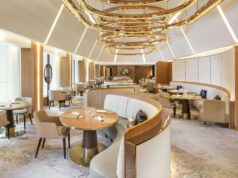The Shining
Directed by Stanley Kubrick
restoration on 4K Blue-ray
“(N)othing is so frightening as a labyrinth with no center.” — Jorge Luis Borges, quoting GK Chesterton*
STANLEY KUBRICK, reportedly dismayed by the poor box office of Barry Lyndon, decided his next project would be a horror film; he skimmed through the first few pages of a stack of books (tossing those that failed to hold his attention in a growing pile), and ultimately settled on Stephen King’s The Shining, about a haunted hotel that turns an alcoholic father against his wife and telepathic son.
King, reportedly involved in the initial stages, was ultimately dismayed with the finished product: he thought the actors miscast (Jack Nicholson as Jack Torrance was obviously crazy from the start, Shelley Duvall as his wife Wendy was basically there to “scream and be stupid”) and recently declared the movie to be “a big, beautiful Cadillac with no engine inside…”
I sought out the book mainly because I’d seen the film, was curious about the source material. Found the book to be a fluidly written if overlong story with a handful of chilling setpieces and plenty of colorful gore; found the characters on the printed page more well-rounded overall than on the big screen, but strictly conventional types in a strictly conventional haunted-house story — maybe with stereo and special effects thrown in to spiffy up the scares.
The movie was a whole other creature (King got that much right). The writer bemoaned Kubrick’s relocating the action to The Timberline instead of The Stanley Hotel that originally inspired him; I also heard a comment that the film doesn’t depict claustrophobia very well, which in the story is one cause of Jack’s madness (the others being supernatural forces and alcohol).
“Of course it doesn’t depict claustrophobia well,” I replied, “and of course it had to be the Timberline” (actually the Timberline’s exterior combined with studio sets inspired by The Ahwahnee Hotel). Danny pedals his Big Wheel furiously down one corridor after another as if in a maze; if you look close you can see that the hotel’s rugs and tapestries depict a similar (if more simplified and stylized) maze; outside he wanders with his mother through an even bigger maze; and the whole film — carpet designs and hotel corridors and hedge maze and all — are an intricately wrought labyrinth set inside Kubrick’s head.
“The horror isn’t of confined space, it’s of limitless space, or rather space that repeats itself over and over, with a possible horror round each corner — but not necessarily. I think the real source of horror is this: a labyrinth with no center, no exit, no reason for being, where the characters are caught like mice in a hopeless spiraling descent with no end.”
I’d heard of people trying to make sense of the hotel’s layout: shots of Danny roving the hallways, shots of the exterior, shots of Kubrick’s camera gliding into this room and that — plenty of clues, very little of it matching or making sense. Partly it’s due to the production — studio sets based off of one hotel, exteriors based off of another — partly I suspect it’s intentional: this maze makes no sense, is not meant to make sense, and anyone attempting to do so (Jack?) will probably go crazy.
Not as big a fan of the film’s latter half, when the plot starts taking over and the horror assumes more conventional dimensions: the skeletons and cobwebs, the doggie man, the party guest with a fractured forehead. Even the blood flooding out of the elevator, while effective in its limited way (and the basis for Kubrick’s creepy TV trailer), doesn’t expand Kubrick’s central thesis so much as ornament it — if Kubrick had cut those images out, I don’t believe the film would suffer.
I do appreciate the subtle cues and unexpected twists and little details dropped along the way to help the narrative along: Danny wandering through the hedge maze (in preparation for a time when he’ll really need that familiarity); Hallorann spending all that time and effort to cross the entire nation, from paradisiacal warmth to infernal cold (Did Kubrick know that in Dante’s The Divine Comedy, hell is already frozen over? Does King?) only in effect to do a special express delivery of his snowcat; Wendy holding her bat midway through its length instead of at its end, sacrificing power for fast, vicious swings.
Much better still are the long scenes between Jack and Lloyd, or Jack and Grady, or (best of all) Jack and Wendy in the hotel’s Grand Lounge — the last employing the Overlook’s cavernous spaces (again the opposite of claustrophobic) in a circuitous, lengthy tracking shot to emphasize Wendy’s vulnerability, Jack’s lunacy, the entire situation’s volatility. Nothing is certain, everything is possible in this labyrinth — that’s the terror of it.
And, yes, the bathroom scene — funny how Kubrick’s more memorable moments often revolve around bathrooms (makes you wonder about the state of his digestive health). Kubrick by way of King stages a harrowing sequence, breaking down actress Shelley Duvall’s sense of self the way Wendy’s sense of self is being broken down by panic and exhaustion and despair — one thinks of Griffith’s Broken Blossoms, and Lilian Gish’s Lucy trapped in a closet, in a near-unwatchable state of hysteria. In a maze you occasionally come to a dead end and are forced to turn and face your pursuer; this is Kubrick’s interpretation of King’s solution to the scenario.
Is the film the greatest horror film ever made? It’s brilliantly perverse, often confounding one’s expectations of what a horror film should look and feel like; it’s also one of the rare horror films that plays on one’s agoraphobia as opposed to claustrophobia (other films would include Hitchcock’s Vertigo, North by Northwest, and The Birds — would include a lot of Hitchcock, come to think of it, his filmography is a near-comprehensive encyclopedia of the differing types of dread). I prefer another film, one explicitly inspired by The Shining that I think goes further to be the finest horror ever made.
Mike de Leon’s Kisapmata turns on a similar premise: a family trapped in a house terrorized by its patriarch. There are touches here there that can be seen as a homage to Kubrick — the nightmare about flooding, the hallway compositions with doors opening and closing — and the sense of being trapped not so much by physical circumstances but by a sense of helplessness and fear. De Leon is working on a far smaller budget with far less time and resources (his hallways for one are much shorter); he evokes simple claustrophobia, working with a middle-class house as opposed to an elaborately constructed hotel. Kubrick, working from King’s novel, does use a massive snowstorm to trap the Torrances in their massive domicile; De Leon’s prison is made of subtler stuff — the bars and chains of Philippine society, of one’s filial duty to one’s parents, and the pressure to obey one’s father.
Mr. De Leon works with so much less to create something that I submit is so much more: a direct horror, no supernatural trappings whatsoever (save for the occasional nightmare), yet superbly Gothic and eerie. One that speaks straight out of the heart of middle-class urban Filipino culture and tradition, yet has warped into something far more perverse, and evil.
* Borges thinks the quote was from the Father Brown story “The Head of Caesar”; he’s right, only what priest actually said was: “What we all dread most… is a maze with no center.”)



